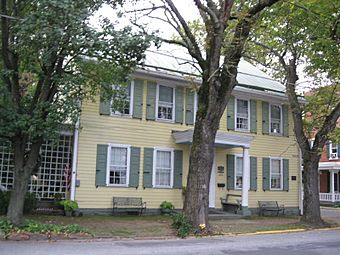Pine Grove Historic District (Pine Grove, Pennsylvania) facts for kids
Quick facts for kids |
|
|
Pine Grove Historic District
|
|

Nutting Hall, Pine Grove, Pennsylvania
|
|
| Location | S. Tulpehocken & Mill Sts., & Swatara Creek, Pine Grove, Pennsylvania |
|---|---|
| Area | 177 acres (72 ha) |
| Architect | Multiple |
| Architectural style | Bungalow/craftsman, Late Victorian, Federal |
| NRHP reference No. | 87002210 |
| Added to NRHP | December 31, 1987 |
The Pine Grove Historic District is a special area in Pine Grove, Pennsylvania, that helps protect old and important buildings. It's like a time capsule showing how the town used to look! This district was added to the National Register of Historic Places in 1987. It covers about 177 acres and includes many old homes, businesses, and other structures. You can find it near South Tulpehocken and Mill streets, and the Swatara Creek.
Contents
What is a Historic District?
A historic district is a special area recognized by the government for its important old buildings and history. The Pine Grove Historic District was officially added to the National Register of Historic Places in 1987. This means its unique character and history are protected for future generations.
Cool Buildings and Structures
Most of the important buildings in this district are homes. They are usually two or two-and-a-half stories tall. Many were built between the 1850s and the 1930s. The oldest house dates back to around 1750!
These homes show off different architectural styles. You can see Craftsman/Bungalow, Federal, Queen Anne, and Second Empire styles. Some also feature Beaux-Arts, Eastlake, Georgian, Gothic Revival, Italianate, or Tudor Revival designs.
Many homes have gable roofs (pointy roofs) with chimneys. They often have wooden siding and double-hung windows. You might also spot front porches with simple columns.
Special Homes to See
- A Bungalow-style home from the 1920s is at 286 South Tulpehocken Street. It has a small wooden dormer (a window that sticks out from the roof) and a porch.
- Nutting Hall is a large wooden home at 205 South Tulpehocken Street. It was built between 1823 and 1825 in the Federal style. It has a metal roof and old-fashioned shutters.
- Another Federal-style home is the Barto residence at 159 South Tulpehocken Street. This brick house from the 1830s has unique round-headed dormers.
- The Miller mansion, built around 1870, is at 191 South Tulpehocken Street. It's a three-story brick home with a mansard roof (a roof with four sloping sides). It has a fancy front porch with detailed carvings.
- Highspire is a beautiful brick Queen Anne-style home from 1900. Located at 177 South Tulpehocken Street, it has decorative glass windows and a tall tower with a pointed slate roof and a cast iron finial (a decorative top).
Other Important Buildings
The district also includes seven commercial buildings, four churches, and a school.
- The Summit Station Manufacturing Company, an old factory, is at 194-196 South Tulpehocken Street.
- The Pine Theater, a brick building at 213 South Tulpehocken, was designed in the Beaux-Arts style.
- An old brick building at 209 South Tulpehocken used to be a coal company office. Later, it became a bakery and then a Masonic Hall.
Churches and More
Saint Peter's Evangelical Lutheran Church is a stone church at 312 South Tulpehocken Street. It has a long history, starting in 1782! The current stone building's foundation was laid in 1816. Over the years, the church has been updated many times.
- In 1851, a bell tower was added with a special bell from New York.
- Between 1870 and 1872, the church was remodeled with a new basement and improved features.
- More changes happened in 1914-1915, adding a stone chancel (the area around the altar) and new art glass windows. A new bell, just like the old one, was installed.
- In 1955, a large addition was built, and the church continued to improve.
The Pine Grove Armory is a brick building at 143 South Tulpehocken Street. It was built around 1908 in a Gothic Revival style. An armory is a place where soldiers train and store equipment. This one was once home to a military company. In 2015, the town of Pine Grove bought the building.
You can also find parts of an old Union Canal basin on the eastern side of the district. There's also a small cemetery on the southern side of South Tulpehocken Street.
Gallery







